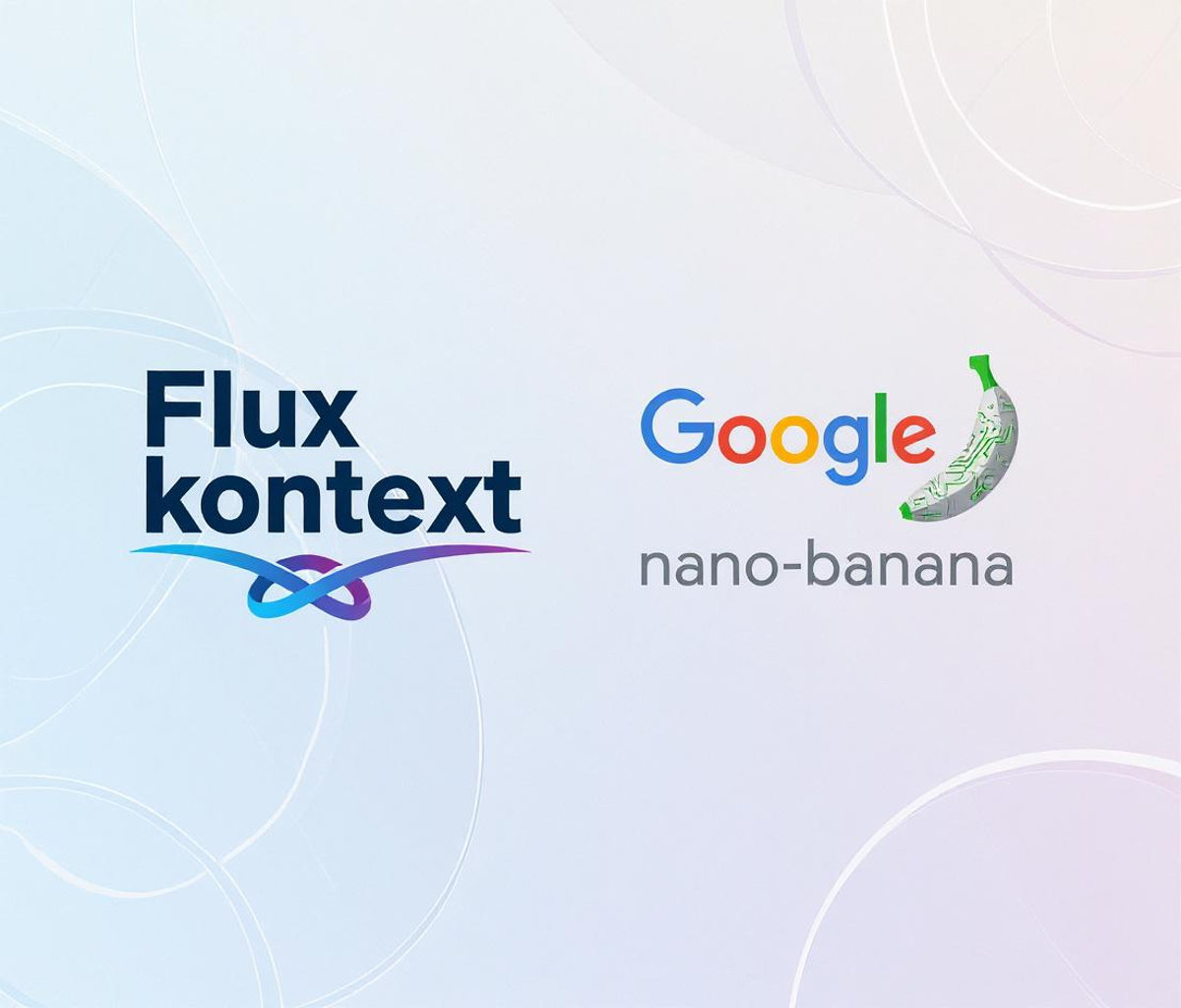I. The New Frontier of AI Image Editing
The field of generative artificial intelligence is undergoing a profound evolution. We were initially amazed by the ability to create beautiful images from text prompts alone, and now, this technological frontier has moved to a new stage: intelligent, context-aware image editing. This shift directly addresses a core pain point in the creative workflow—how to maintain the consistency of characters and scenes across multiple edits and generations. It is no longer just about creating new images, but about making precise, meaningful modifications based on existing visual concepts to enable seamless creative storytelling.
This blog helps analyze two heavyweights in this space. On one side is the Flux-kontext series from Black Forest Labs, a highly-regarded family of models that offers open-source and professional versions for a variety of user needs. On the other hand is the highly anticipated and officially unveiled Google nano-banana (codenamed Gemini 2.5 Flash Image). This blog is to move beyond marketing hype to provide creators and developers with actionable advice by clearly and practically comparing the models' capabilities, features, strengths, weaknesses, and the strategic intent behind them.
II. The Flux-kontext Ecosystem: A Three-Pronged Strategy
The Flux-kontext suite is built on generative flow matching models, enabling "context-aware" image generation using both text and images as input prompts. This means the models can intelligently understand and modify existing images, allowing for instant edits without complex fine-tuning or workflows. Its core features include:
● Character and Scene Consistency: The ability to keep key elements like character features and compositional layouts stable across multiple edits.
● Local Editing: The ability to make targeted modifications to specific elements without affecting other parts of the image.
● Style Reference: The ability to generate new scenes while preserving the unique style of a reference image, guided by text prompts.
● Iterative Workflow: The model is designed for step-by-step refinement with minimal latency.
The model family is divided into three versions, each with its own unique positioning and features.

Flux.1 Kontext [dev]: A Leader in the Open-Source Space
The dev version is the unique open-source model in the series, with 12 billion parameters that allow it to run locally on consumer hardware. The model's open weights are available on Hugging Face and GitHub and operate under a non-commercial license, primarily for research and experimentation.
The dev model has a strong user base in the community, particularly within ComfyUI workflows. ComfyUI lovers are actively exploring its potential as an alternative to traditional tools like ControlNet, which demonstrates its wide range of applications. Black Forest Labs' decision to release this powerful open-source model under a non-commercial license is a highly strategic move. It cultivates a vibrant community of developers and researchers who provide free feedback, bug reports, and create new workflows, and this community engagement builds brand loyalty and creates a conversion path for enterprise users. The non-commercial license ensures that businesses wishing to use the model for commercial, revenue-generating projects must pay for the API version, successfully turning community-driven innovation into a profitable business model.
Currently RunC.AIfor Community has uploaded the Flux Kontext Dev workflow image. By simply deploying the image, users can run the workflow without downloading the original model files.
Flux.1 Kontext [pro]: A Reliable Tool for the Commercial Sector
The pro version is the workhorse of the series for commercial applications and is available exclusively through an API. It is designed for fast, iterative image editing, serving as a "unified model" capable of local editing, generative modifications, and text-to-image generation. Priced at $0.04 per image, with an average generation speed of 8 to 10 seconds, it is an ideal choice for production systems that require both quality and cost-effectiveness.
Flux.1 Kontext [max]: The Flagship for Ultimate Performance
The max version is positioned as the "flagship" and "premium" model in the series, focusing on "maximum performance across all aspects". Its main advantages are significantly improved prompt adherence and typography generation capabilities. At $0.08 per image, it is the most expensive in the series. Its generation speed is slightly slower, around 10 to 12 seconds, which reflects its focus on fidelity over raw speed. This version primarily serves large enterprises or scientific research projects that demand the highest level of performance.
III. The Rise of a New Contender: Google's nano-banana (Gemini 2.5 Flash Image)
For weeks, nano-banana was a mysterious and highly sought-after anonymous model on the LMArena platform, and many were trying the model and posting their results on Reddit or Twitter. Many were guessing: which company does it belong to? This speculation has now been confirmed: it is Google's Gemini 2.5 Flash Image editing model, which is available at Google AI Studio now, and as part of the Gemini 2.5 ecosystem, it is redefining the performance standards for AI image editing.
Disruptive Core Strengths
Nano-banana possesses several widely recognized disruptive advantages:
● Exceptional Character Identity Preservation: This is the model's most acclaimed feature. User reports and blog posts consistently praise its "microscopic accuracy" in maintaining a subject's facial features and identity across multiple edits, with some comments even stating it "completely destroys Flux Kontext". This core strength is crucial for storyboarding, character sheets, and marketing campaigns.
● Blazing-Fast Processing Speed: The model is known for being "very fast", with response times typically between 1 and 2 seconds, and is reportedly 8 times faster than comparable models like Flux-kontext. This speed difference is more than a simple performance metric; it fundamentally changes the user's workflow. A 10-second wait creates a cognitive break, turning the process into a "batch mode". A 1 to 2-second response time makes the interaction feel more "conversational" and "real-time", enabling a continuous, fluid creative loop that supports rapid ideation and refinement. This advantage is particularly critical for real-time applications and APIs.
● Multi-Image Fusion and World Knowledge: Another core capability of nano-banana is its ability to seamlessly fuse multiple images into one coherent new visual based on a single prompt. This unlocks powerful use cases like virtual product photography and virtual try-ons. Furthermore, the model leverages Gemini's deep "world knowledge" to achieve semantically more accurate generations.

Availability and Limitations
Unlike Flux [dev], nano-banana does not have an open-weights version. It is a closed-source API service available only through the Gemini API, Google AI Studio, Vertex AI, and partners like Fal.ai. It's also available for embedding in a ComfyUI workflow through API, priced $0.039 per image. This might be a limitation for users who value the open-source community and local deployment. Furthermore, like most generative AI models, nano-banana has some common flaws, such as anatomical errors with hands and fingers, and a weak ability to generate legible text within images. The model also lacks public technical papers or official documentation, making it difficult for researchers to understand its underlying architecture.
IV. Head-to-Head: A Multi-Dimensional Comparison
Performance Benchmark: The LMArena Verdict
The most objective and compelling evidence comes from the LMArena Image Edit leaderboard. nano-banana (Gemini-2.5-Flash-Image-Preview) ranks first with over 2.5 million votes, far surpassing Flux-kontext [pro] with around 2 million votes and [max] with around 357,000 votes. This overwhelming victory on a blind-test platform validates the qualitative user reports with hard data. The large gap in votes is not a coincidence; it powerfully confirms that nano-banana offers a superior user experience in core strengths like character consistency and prompt understanding.
Core Feature Analysis
● Character and Object Consistency: While Flux-kontext claims "excellent" consistency, nano-banana also shows great performance.
● Complex Instruction Handling: nano-banana shows a stronger ability to understand and process multi-step editing instructions and often achieves the desired result on the first try. In contrast, Flux may require more precise prompt engineering or complex ComfyUI workflows.
● Text Editing: Flux-kontext may have an advantage here. The [pro] and [max] versions claim "excellent" text preservation, and their API is designed for text replacement. In contrast, nano-banana's text generation is widely reported to have "problems".
Deployment and Ecosystem: The Strategic Divide Between Open and Closed Source
● Flux-kontext [dev]: Offers unparalleled freedom, privacy, and control, as it is a local, open-source model where all data remains on the user's device.4
● nano-banana: Operates as a cloud-native, API-only service, providing convenience and powerful performance at the cost of requiring users to entrust their data and control to the cloud.
These two distinct deployment models represent two different paths for the market. The path represented by Flux [dev] is for developers who prioritize open innovation, customizability, and data privacy. The path dominated by nano-banana is for a broader user base, including professionals and general consumers, who value speed, performance, and ease of use, even if it means operating within a closed-source ecosystem. The choice between them is ultimately a user's consideration of fundamental values.
Economic Analysis
● Pricing Comparison: nano-banana's API price of $0.039 per image makes it slightly cheaper than Flux [pro]'s $0.04 and significantly less expensive than [max]'s $0.08. The Flux [dev] API is the most economical choice at just $0.025 per image. To deploy Flux Kontext Dev version locally is free.
● Value Proposition: This analysis shows that nano-banana offers competitive pricing while delivering superior performance. However, for users with sufficient local hardware, Flux [dev] remains the most cost-effective solution as it can bypass API fees entirely.
V. Summary and Strategic Recommendations
The analysis in this blog clearly shows that nano-banana, with its exceptional speed and character consistency, has made a significant leap in the API-driven, cloud-native image editing market and has set a new industry benchmark. At the same time, Flux-kontext, especially its [dev] version, occupies a unique and crucial niche, becoming one of the most powerful open-source, locally deployable image editing models. Therefore, the choice between them is not a matter of which is superior, but depends on the user's priorities and workflow. For AIGC lovers, deploying Flux dev freely is an economical choice, and now RunC.AI has uploaded an image for users to experience the open-sourced model without downloading anything. To run it on RunC's instance, it is economical, fast, and convenient. RunC.AI also provides workflows to use Flux Kontext Pro and Max versions, which require users to log in to their ComfyUI account.
The intense competition between open-source models like Flux [dev] and powerful closed-source models like nano-banana is shaping the future of generative AI. This dynamic will continue to push the boundaries of technology and force us to reconsider the balance between collaborative open innovation and efficient proprietary innovation.
About RunC.AI
Rent smart, run fast. RunC.AI allows users to gain access to a wide selection of scalable, high-performance GPU instances and clusters at competitive prices compared to major cloud providers like Amazon Web Services (AWS), Google Cloud, and Microsoft Azure.


